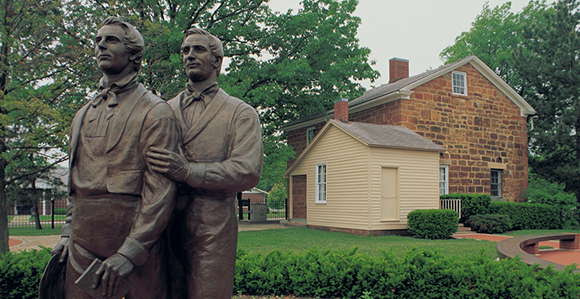Elder LeGrand R. Curtis Jr. Explains How “Millions Shall Know Brother Joseph”
Contributed By Elder LeGrand R. Curtis Jr., Church Historian and Recorder

A view of Carthage Jail with a statue of Joseph and Hyrum Smith.
Article Highlights
- Even after Joseph Smith’s death, the everlasting gospel rolled forth across the earth.
- Since William W. Phelps wrote “Praise to the Man,” millions have come to know Brother Joseph.
- Brother Joseph is known on both sides of the veil.
Related Links
The Restoration of the gospel began in the spring of 1820 as Joseph Smith heeded Heavenly Father’s invitation to “hear Him”—that is, listen to the words of Jesus Christ. Commencing with the First Vision, and throughout the rest of his life, that is what Joseph did.
Heeding the words of the Savior and heavenly messengers sent by Him resulted in the translation of the Book of Mormon, the restoration of the priesthood, the organization of God’s true Church, the restoration of temple ordinances, and much more. By the time Joseph was killed by mob violence in 1844, the everlasting gospel had been restored and was rolling forth across the earth.
The mourning for Joseph and his brother Hyrum was poignant. Six weeks after their deaths, Brigham Young wrote: “It has been a time of mourning since the day that Joseph and Hyrum were brought from Carthage to Nauvoo. It was judged by many both in and out of the Church that there were more than five barrels of tears shed. I cannot bear to think anything about it.”
In addition to tears, there were sermons, poems, and a tribute that was later canonized as Doctrine and Covenants 135. One of the poems was written by William W. Phelps shortly after Joseph’s martyrdom. He entitled it “Joseph Smith,” and it was first published in the Times and Seasons. It became a beloved hymn of the Restoration that we know today as “Praise to the Man.” The hymn is a touching tribute to Joseph. Just before the final chorus there is this intriguing sentence: “Millions shall know ‘Brother Joseph’ again.”
It is easy to chalk that line up to sentimental exaggeration by a friend and admirer. After all, at the time of Joseph’s death there were only about 26,000 members of The Church of Jesus Christ of Latter-day Saints, and many critics anticipated that the Church would fade into oblivion after Joseph’s killing. But the truth is, since Phelps wrote that poem, millions have come to know Brother Joseph.
Think of some of the ways that people have come to know Joseph Smith since 1844:
-
There have been around 20 million members of the Church on this earth, including more than 16 million currently living. Before and after baptism, these millions have come to know Joseph by learning about his life and teachings. For example, as they study copies of the Doctrine and Covenants and Pearl of Great Price, they read the revelations and translations received by Joseph.
-
Over 185 million copies of the Book of Mormon have been printed and distributed in over 100 languages. Millions have read portions of Joseph’s history in the introduction to the Book of Mormon and, more importantly, have received a testimony of his prophetic call by reading and praying about the Book of Mormon.
-
Each year missionaries tell millions about Joseph. Many also receive tracts from the missionaries recounting Joseph Smith’s remarkable story in his own words.
-
Church historic sites in Vermont, New York, Pennsylvania, Ohio, Missouri, and Illinois commemorate Joseph’s life and ministry, allowing individuals to be in sacred settings where the Lord revealed much to Joseph Smith. These sites have provided millions of people the opportunity to come to know Joseph through the interpretation of events in his life in their historical context.
-
Technology and recent historical publications have made it easier than ever for people to know Brother Joseph. A vast trove of information is available in the Joseph Smith Papers volumes and josephsmithpapers.org website. Saints, Volume 1 narrates Joseph’s life and the Restoration of the gospel like never before. Further materials recently produced by the Church make Joseph even more accessible, including Revelations in Context: The Stories behind the Sections of the Doctrine and Covenants, Church History Topics, the various accounts of the First Vision, short videos, and podcasts.

Actors portray Joseph Smith and Oliver Cowdery finishing the translation of the Book of Mormon.
All the items mentioned above refer to those who have known Brother Joseph on this side of the veil. But we know that the work of salvation and exaltation goes forth on the other side of the veil also.
In Joseph F. Smith’s vision of the redemption of the dead (Doctrine and Covenants 138), he saw messengers from various dispensations taking the joyous news of the gospel to those who died without it. Included among the messengers was Joseph Smith himself. Certainly, part of the message carried forth in the spirit world is the Restoration of the gospel and that the saving ordinances revealed to Joseph Smith are available to the dead vicariously.
Since William Phelps wrote his poem, millions have, indeed, come to know Brother Joseph. And millions more will.
